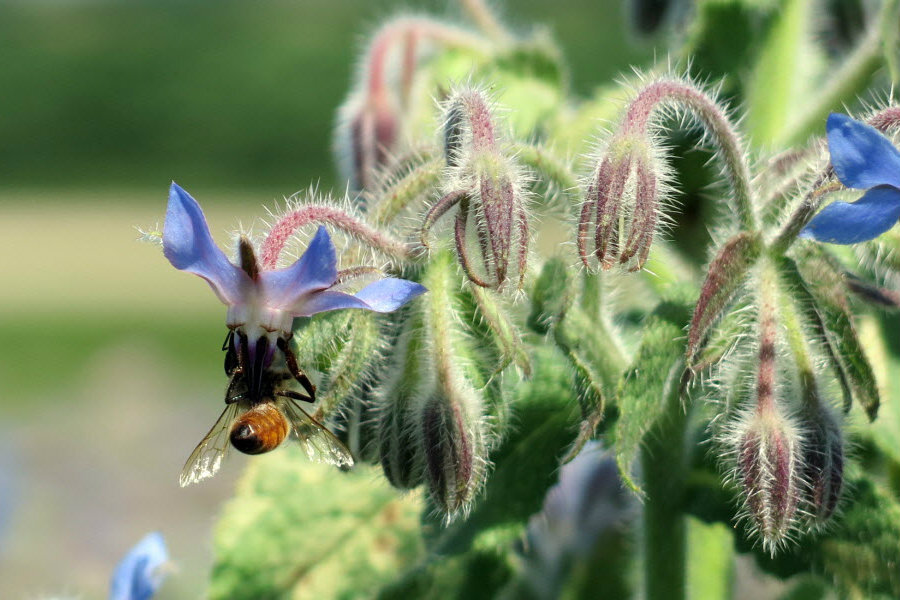Could adorable tiny tech backpacks save the honeybees?
Loading...
Microsensors may be the key to solving the mystery behind the collapse of honeybee colonies.
Australian researchers announced Tuesday that they have attached tiny, top-of-the-line trackers to about 10,000 healthy honeybees in an effort to find out what is driving a decline in the pollinators’ global population. The experiment, supported by an international group of scientists, farmers, beekeepers, and tech companies, is the latest to use tracking and tagging technology to study animal behavior and responses to stimuli.
"The tiny technology allows researchers to analyze the effects of stress factors including disease, pesticides, air pollution, water contamination, diet, and extreme weather on the movements of bees and their ability to pollinate," said Dr. Paulo de Souza, science leader at Australian science agency CSIRO, which helped develop the technology, in a statement. "We’re also investigating what key factors, or combination of factors, lead to bee deaths en masse."
The tiny sensors, like the electronic tags that monitor cars on toll roads, send data back to receivers – about half the size of a credit card – that are placed in honeybee hives, the BBC reported. The trackers, attached to the pollinators’ backs, weigh about a third of what a bee can carry.
The bee backpacks are the latest innovation in a series of high-tech tracking devices and sensors designed to both study and protect declining animal populations. Electronic tagging and tracking tools, for instance, now provide marine biologists with more detailed data than ever on the migration patterns of sharks and other aquatic species, and help identify the marine habitats that need special protection, according to National Geographic.
UK-based conservation company Protect recently developed a monitoring and alarm system that alerts authorities when a poach is taking place, using a camera embedded painlessly into a rhino’s horn. And researchers at the University of Minnesota employed GPS collars and cardiac “biologgers” – devices that track heart rates – to measure grizzly bears’ stress levels in the presence of drones.
Similar technology is also being used to study everything from the migratory patterns of birds, to the amounts of energy big cats expend when hunting prey, to the social behavior of monkeys, according to a study published in June in the journal Science.
“Multi-sensor tracking tags are not only changing what we know about where animals go, they are also transforming what we know about how animals interact,” the study found. “With global change causing ongoing and accelerating loss of biodiversity, a more mechanistic and detailed understanding of the space requirements and environmental associations of animals is pressing.”
In the case of honeybees, scientists hope to figure out what’s behind colony collapse disorder, a syndrome characterized by the mysterious death or disappearance of adult worker bees, causing whole colonies to fail. In the United States alone, nearly a third of bee colonies have vanished due to the disorder, according to the National Resources Defense Council.
"In some parts of the world, a healthy hive of bees can be like clockwork one day, and then every single bee is dead the very next day, and we have no idea why," CSIRO’s Dr. Souza told the BBC.
The syndrome, coupled with habitat loss, pesticides, disease, and parasites, has devastated wild bee populations worldwide. If left unchecked, these factors could threaten global and domestic agriculture and food production, which are dependent on pollination. As The Christian Science Monitor previously reported:
Honey bees are vital to both local ecosystems and the economy. Bee pollination accounts for more than $15 billion in increased crop value every year, according to the USDA, and is crucial to growing plants that produce a quarter of the food consumed by Americans.…
If losses continue at the current rate – or worse, continue to rise – “it could threaten the economic viability of the bee pollination industry,” the USDA warned. “[T]he cost of honey bee pollination services would rise, and those increased costs would ultimately be passed on to consumers through higher food costs.”
CSIRO, in cooperation with US tech firm Intel and Japanese conglomerate Hitachi, has already tagged bees and hives in Tasmania, where the population decline is less severe. Scientists from Europe and North America have also expressed interest, Agence France-Presse reported.
"What we are gathering with the sensors is environmental information from where the bees have been," Gary Fitt, science director of the CSIRO's health and biosecurity division, told the wire service. "[We'll] use the same approaches and ask similar questions but in different parts of the world to get a much bigger picture of the problem and collectively find solutions."






